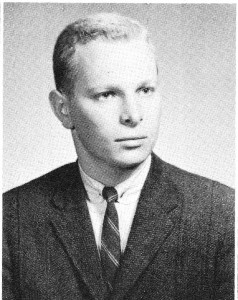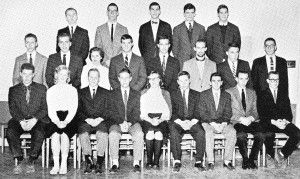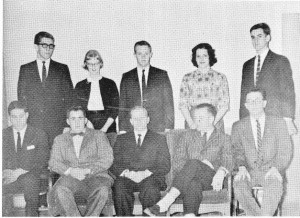The program was Ed Rothchild’s inspiration, to be called “Insomnia”— A solid three hours of home-grown comedy to be broadcast live from the studios of WRMC at Middlebury College in Vermont. It was the early spring of 1958 when Ed and I were freshmen. By then I was heavily involved in the radio station; everything there was so much more exciting than anything my professors had to offer in the seven classes (including Phys Ed and ROTC) that I was signed up for. Of course, I went to my classes, took illegible notes, attended chemistry lab, did some of my math homework and passed some of my exams. And whenever I could escape these dreary and overwhelming duties, I headed for the WRMC studios. After all, I was the News Director had to check that the UP teletype machine hadn’t run out of paper or worn out its ribbon.
I have forgotten most of the actual content of the Insomnia marathon, but I remember what I had to do to prepare for it. It was my job to produced tape-recorded sound effects for the show, including background music. And how did this assignment come about? Well, I owned a tape recorder, and could borrow a second one, no less. The editing job required recording sound snippets from various records onto one of the tape machines, and cutting the recorded tape segments to exactly the right length. Then I spliced white leader tape between all the sound effects segments and wrote what the segment was on the leader. For the section requiring lots of chickens clucking, I wrote “chickens” on the leader preceding it.
The chickens were needed for one of the commercials to be used in the show—for a bogus product called “Furdsot,” a sheep dip. Furdsot was a product of Ed Rothchild’s fertile imagination. To Ed, who grew up in the New York area, anything suggesting farming was funny, including the early morning agricultural forecasts that we heard on the radio. After all, Middlebury College was located in an area dominated by dairy farms, but to Ed it might as well have been Dogpatch. Ed didn’t read the Furdsot commercial himself; instead the job fell to a student who could muster a better hillbilly accent than Ed could. In the control room I cued my tape machine and brought up the barnyard sounds as the commercial began.
This preparation consumed a huge amount of time, far more than I devoted to my studies. In the rush to get ready for the Insomnia broadcast I worked late one cold winter night with Ed and other students. We took a break in the larger of the two studios, a room with a couple of old arm chairs and a worn rug. On the wall was a faded reproduction of a romantic era painting: a partially draped woman reclining on a couch. “Look at that sly nipple,” Ed had commented when he first spotted the partly revealed breast in the painting. I relaxed in one of the arm chairs right under this picture and decided not to go back to my dorm, but to sleep right there in the studio. I didn’t get much rest and by dawn, I was exhausted. I dragged myself back to my dorm and flopped on my bed, missing two of my morning classes. It’s no wonder that I flunked out the following year.
If Rothchild wasn’t up to a convincing farmer’s accent, he was a natural for the heavy Russian enunciation required in the next bogus commercial—for a Soviet product called “Sverdgorsky’s Preboiled Instant Borscht.”
Comrades, don’t spend hours shredding beets and other vegetables when you can save all that precious socialist labor for something more worthy. Instead, use Sverdgorsky’s Preboiled Instant Borscht. It’s flavor buds leap from the pot and belch at you. On your next rip to Siberia, pack a can or two. You’ll be glad that you did.
Epilogue: Even the new transmission system installed by John Bowker in 1960 couldn’t reach all the college’s dorms with a good AM signal and by the mid sixties it became clear that a conversion to FM was needed. In 1967, the FCC granted the college a license for a ten-watt FM transmitter, with a broadcast antenna to be located on top of the tallest campus building, Mead Chapel. In the years following the switch to FM, WRMC experienced just as many technical crises as we and our predecessors had. There were periods when the station was off the air, just as there had been when I was a student, according to the 1981 history written by Don Kreis. Today, WRMC thrives with a 2900-watt stereo FM signal that covers the Champlain Valley in Vermont and can be heard worldwide over the internet.
Many of us who volunteered for WRMC believed that we might find careers in broadcasting after college. I visited an AM station in Boston and even auditioned for the WESX, the local station in Marblehead where I grew up, but nothing came of it. Instead, I went on to graduate school in psychology. Ed Rothchild, sold office machines after college, worked in the music industry, and became a pioneer in the promotion of compact disc recordings. He married his longtime girlfriend Gail but died in 1992 after a long illness. Lorrie Kittredge Rogers lives in Connecticut, has grown children, and retired after a distinguished career as a pension actuary. Leelaine Rowe Picker also lives in Connecticut where she directed a nursery school. Peter Talbot, who had the best radio voice of any of us, became a director of the NYNEX telephone company and retired to Florida. So did John Bowker, Jr., WRMC’s founder, after his retirement from RCA.
Next week: Montreal




